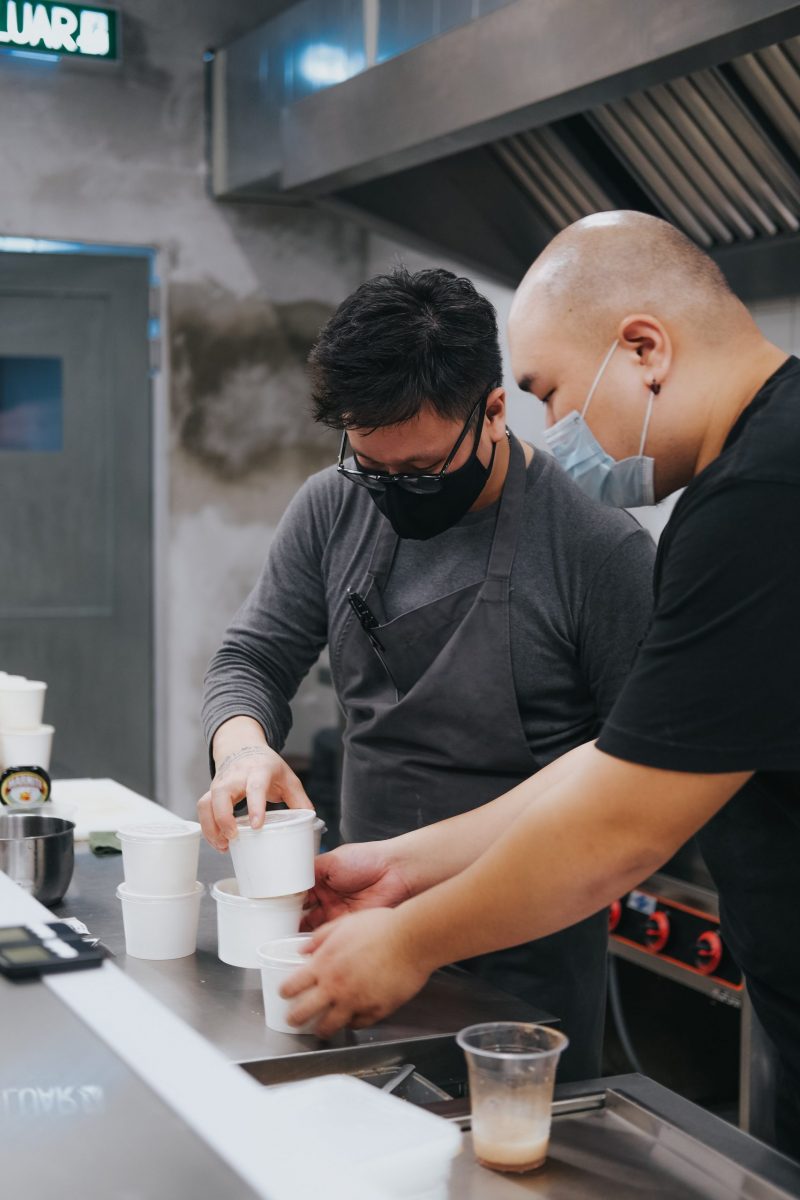The National Restaurant Association administers the ServSafe Manager Certification exam as a part of the ServSafe Food Safety Training Program whose goal is to assist in educating the food service industry on all aspects of food safety. In this guide, Servsafe-Prep will show you everything you need to know about Servsafe Manager.
The ServSafe Manager Certification verifies a manager’s ability to protect the public from foodborne illness. The certification is accredited under the Conference for Food Protection Standards by the American National Standards Institute (ANSI). The training program includes essential practices for food safety and the latest FDA Food Code.
In this Servsafe Manager Study Guide, we’ll indicate the overall knowledge you must grasp to have a strong foundation for your coming exam!
General Information – ServSafe Manager Study Guide

The ServSafe Manager certification is a mandatory certification for individuals who want to rise to a management position in the food service industry. It is not merely a test of your basic knowledge related to the food service industry but also helps to assess your understanding of food safety, such as preventing diseases related to eating. The Manager material will have effective materials for study and exam preparation, especially when viewing the study guide and practicing questions for the ServSafe Food Manager test.
The test consists of 90 questions in total and the candidate will only be allowed to complete them all within a limited time. Therefore, you need to know that the concepts in the test will be more advanced and more difficult than those that are given on the food handler test as well as you should be aware that the ServSafe Manager study guide will be beneficial for your preparation process for this test. Let’s ensure that you’ve already accessed our ServSafe Manager practical questions as well as ServSafe Manager flashcards for associated topics to complete all of them for your upcoming test.
The following concepts are covered in the ServSafe Manager training:
- Food Contamination
- The Safe Food Handler
- The Flow of Food
- Food Safety Management Systems
- Safe Facilities and Pest Management
- Cleaning and Sanitizing
Note: If a candidate does not pass the ServSafe exam, he or she may retake it within a 30-day period. You will have to wait 60 days before retaking the exam if you do not pass it the second time.
Food Contamination Concept
A disease transmitted to people through food is referred to as a food-borne illness. The three sources of contaminated food are:
- Physical contamination is the type of food contamination caused by hair, glass, metal, shavings, broken objects, dirt, etc.
- Biological contamination is the type of food contamination caused by pathogenic bacteria, viruses, fungi, or parasites.
- Chemical contamination is the type of food contamination caused by substances including pesticides, cleaning compounds, acids, detergents, soaps, chemicals, etc.
Infants, preschool-age children (4 years and younger), pregnant women, the elderly (65 years and older), and people with compromised immune systems are more susceptible to food-borne illness because of their weak immune systems.
Some of the foods which are more conducive to the quick development of microorganisms than others require Temperature Control For Safety (TCS). They are Milk, Eggs, Shellfish, Fish, Meat, Meat Alternatives, Untreated Garlic & Oil Mixtures, Baked Potatoes, Raw Sprouts, Cooked Rice, Cut Tomatoes, and Cut Melons. To avoid microbial development and the creation of toxins, TCS foods must be kept out of the Danger Zone (41-135°F).
The Safe Food Handler Concept
Food handlers run the risk of contaminating food if they have a foodborne illness, exhibit gastrointestinal symptoms, have infected lesions, or come into contact with anything that might contaminate their hands.
It is imperative to constantly wash your hands properly since even seemingly harmless behaviors like picking your nose or stroking your hair can contaminate food. You should wash your hands before working, after using the restroom, and after sneezing, eating, drinking, handling raw food, smoking, or handling rubbish. The proper hand-washing procedure includes the following steps:
- Turn on the hot water to 100°F
- Apply soap
- Scrub your arms and hands for 10 to 15 seconds
- Rinse
- Air dry or dry with a single-use towel
Hand antiseptic used in establishments must have FDA approval as a food additive.
A food handler’s nails must be short and clean. Cuts and wounds must be covered with clean bandages and a finger cot or gloves. Never wear gloves in place of washing your hands. Before putting on gloves and after switching to a new pair, you must wash your hands thoroughly. Food-handling gloves are single-use items that should never be cleaned or reused. They must be replaced at least every four hours, whenever they get dirty or rip, or whenever a new task is started.
Before work, all employees are required to take a shower or a bath and keep their hair clean. Employees must put on clean clothes, proper shoes, and a clean cap or hair restraint before handling food. Their hands and arms must be free of jewelry. When an employee exits an area where food is being prepared, their apron should always be taken off. When preparing, serving, or working in food-prep areas, employees are not allowed to eat, drink, smoke, or chew gum.
If employees have a sore throat with a fever, they must be restricted from working with or around food. Employees with active jaundice, diarrhea, or vomiting must wait 24 hours after they are symptom-free before they can resume work. Employees diagnosed with Salmonella, Shigella, E. Coli, Hepatitis A, or Norovirus must be excluded and reported to the Health Department.
The Flow Of Food Concept
Purchasing & Receiving
The approved supplier has undergone inspection and complies with all local, state, and federal laws. Operators must organize delivery schedules in advance to ensure that goods are handled quickly and promptly. Employees who are responsible for receiving deliveries should have sufficient training on how to evaluate food and tell what is acceptable from what is not. Packaging should be undamaged, clean, use-by-dates current, and there should not be any indications of mishandling.
Below are the properly delivered temperatures of some products:
- Cold TCS Foods: 41°F or lower
- Shell Eggs and Live Shellfish: 45°F or lower
- Hot TCS Foods: 135°F or higher
Preparation
Food that has been frozen can be thawed in a microwave, refrigerator, under cool running water, or during the cooking process. Food should never be defrosted at room temperature.
Use bowls, utensils, and pre-chilled ingredients to prepare food in small batches.
The number of microorganisms in food can be safely decreased through cooking. Food must be cooked to the following minimum internal temperatures to ensure that bacteria are eliminated.
- Chicken, stuffed meats, stuffed pasta, leftovers, and microwave-cooked food: 165°F
- Eggs to be held, ground meat, injected meat: 155°F
- Eggs short order, steak, chops, fish, roast: 145°F
- Vegetables, fruits, pasta, beans, and commercially processed RTE: 135°F
Leftover TCS food needs to be reheated to a minimum internal temperature of 165°F for two hours.
Service
Food that is being held should have its internal temperature checked at least every four hours, and if it is not at the right temperature, it should be discarded. (135°F or higher for hot holding and 41°F or lower for cold holding).
A maximum of four hours might be allowed for holding hot food. Cold food must be kept at 41°F or lower before being removed, must never rise over 70°F once removed, and must be labeled with the time it was removed and the time it should be discarded, which can be a maximum of six hours.
Food Safety Management Systems Concept
The five most common risk factors for a foodborne illness identified by the CDC are the focus of Active Managerial Control. These include buying food from unsafe sources, not cooking food properly, storing it at the wrong temperature, using contaminated equipment, and poor personal hygiene. Active Managerial Control procedures include the following steps:
- Take into account the five risk factors for the entire flow of food
- Determine any problems in your establishment that could affect food safety
- Create guidelines and regulations that address any identified issues
- Check to see if your new rules are being adhered to
- Verify the effectiveness of the rules and procedures you have established
In order to prevent, remove, or decrease biological, chemical, or physical risks to a safe level, the Hazard Analysis Critical Control Point (HACCP) system focuses on the following steps:
- Perform a hazard analysis
- Identify the critical control points at which the hazards can be lowered to a safe level, removed, or prevented
- Determine the maximum and minimum limits that each Critical Control Point (CCP) must meet
- Establish monitoring procedures
- Determine the corrective measures that will be done if critical limits are not met.
- Check to see if your plan is effective
- Create record-keeping and documentation procedures
Safe Facilities And Pest Management Concept

Safe Facilities
Flooring should be non-absorbent, strong, durable, easy to clean, and aid in preventing slips, particularly in walk-ins, kitchens, dishwashing areas, restrooms, and other places subject to moisture or spray cleaning. Carpeting absorbs sounds; therefore, it is only recommended in dining rooms, not in places with high soil content.
Restrooms must have a hand washing station with hot and cold water, soap, a means to dry hands, a trash container, and signage stating that employees must wash their hands before coming back to work. Restrooms should also be frequently cleaned.
In an establishment, drinking water is essential. Public water mains, private water sources that are tested at least once a year, and bottled water are some sources of drinking water. If specific precautions are followed, an establishment may be permitted to stay open during a water emergency. These could involve buying water, heating water for hand washing, or performing other necessary duties.
The intensity of lighting for specific areas is specified as follows:
- A food prep area: 50 foot-candles
- Hand washing, restrooms, wait stations, buffet, and display areas: 20 foot-candles
- Inside walk-in refrigerators, dining rooms, dry storage areas: 10 foot-candles
By eliminating heat, steam, smoke, and grease, adequate ventilation enhances the quality of the air indoors. Grease and condensation will not accumulate on walls and ceilings if there is enough ventilation. Ventilation must be designed so that hoods, fans, guards, and ductwork do not drip onto food or equipment. Grease extractors and hood filters need to be cleaned frequently.
Garbage containers need to be long-lasting, easy to clean, leak-resistant, waterproof, and pest-proof. They need to be covered when not in use. All trash cans need to be cleaned carefully on a regular basis, both inside and out. Garbage should never be carried across a food-prep area and should be taken out of the area as soon as possible.
Pest Management
Denying pests access, to food, shelter, and water is part of Integrated Pest Management (IPM), which also entails working with a certified Pest Control Operator (PCO) to get rid of any pests that get in.
Pesticides are dangerous. You are required to have a corresponding MSDS for each time they are used or stored on your premises. Have your PCO apply pesticides when you are closed and none of your personnel are on the site to reduce the risk to people. After treatment, make sure to wash, rinse, and sanitize any food contact surfaces.
Cleaning and Sanitizing
The act of cleaning involves removing food particles and other kinds of soil from a surface. Sanitizing means bringing the number of harmful microorganisms on a clean surface down to safe limits. Before sanitizing, a surface needs to be cleaned and rinsed. Contact time, sanitizer concentration, and solution temperature all have an impact on chemical sanitizers. Use a sanitizer test kit to periodically test the solution.
Every time you work with a different type of food, whenever a task is interrupted, or every four hours after being in constant use, food-contact surfaces need to be cleaned and sanitized. Four steps are involved: wash, rinse, sanitize, and air dry.
Make sure your dishwashing machine is clean and in good working condition according to the manufacturer’s guidelines. Check the pressure and temperature of the wash and rinse cycles every day. Proper water temperature, conveyor speed, water pressure, and chemical concentration should all be indicated on the machine.
Items cleaned in the three-compartment sink should be pre-soaked or scraped clean, washed in detergent with 110°F water, rinsed in clean water, either sanitized in hot water at least 171°F or with a chemical-sanitizing solution and then air-dried inverted.
It is best to store cleaning tools and chemicals away from places where food is prepared and served. If chemicals are taken out of their original containers, be sure they are properly labeled. Each chemical’s Material Safety Data Sheet (MSDS) should be accessible to everyone on the job. These sheets contain crucial information on safe use and first aid. Chemicals must be disposed of in accordance with the instructions on the label and local regulations.
FAQs
Conclusion
In conclusion, this article has provided you with the most up-to-date information about the ServSafe manager study guide. We hope that this piece of knowledge can help you in the preparation process. Visit our websites to get more information and take our free ServSafe practice test pack. Hope that our free ServSafe Study Guide 2024 helps you gain all the essential knowledge for your coming exam! To download, visit our website for both IOS and Android devices.



